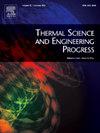一个独特的热系统,加上热能和碳捕获和储存选项
IF 5.1
3区 工程技术
Q2 ENERGY & FUELS
引用次数: 0
摘要
在这项工作中,城市固体废物(MSW)和太阳能热驱动的三联发电系统用于电力,空间供暖和淡水生产的开发和热力学评估。这项工作的新颖之处包括使用安大略省列出的MSW成分,作为空气-布雷顿循环的燃料,以及通过水管将热泵耦合到它,以进行热脱盐和空间加热应用。利用相应的系统关键部件的质量、能量、熵和火用平衡方程以及工程方程求解器(EES)进行相关计算。集成热泵采用R134a制冷剂,在有阳光时由太阳能集热器驱动,其他时间通过显热储能驱动。在标称运行条件下,考虑辐照度为800 W/m2,能量效率和火用效率分别为37.43%和24.55%。在相同工况下,其性能系数为2.72。对于更具体的位置计算,使用了加拿大安大略省达勒姆地区的太阳剖面,并获得了辐照度的年平均值。这导致了能源和火用效率在日常运行中的变化,它们分别在52.56%到43.98%和35.67%到29.27%之间。白天的蓄热充电容量在2,625 kWh到12,985 kWh之间,在没有阳光的时期,平均放电容量为6,297 kWh,能量和火用效率分别为49.43%和33.3%。当参考温度从296.15 K增加到340 K,辐照度为800 W/m2时,参考温度的变化也被考虑,当参考温度从296.15 K增加到340 K时,火用效率从24.55%下降到23.38%。最后进行了相应的火用破坏计算,确定了改进的空间。本文章由计算机程序翻译,如有差异,请以英文原文为准。
A unique thermal system coupled with thermal energy and carbon capturing and storage options
In this work, a Municipal Solid Waste (MSW) and solar thermal driven trigeneration system for power, space heating, and freshwater production is developed and thermodynamically assessed. The novelty of this work includes the use of MSW composition listed for Ontario, as fuel feed to an air-Brayton cycle, as well as coupling a heat pump to it through water conduits, to carry out thermal desalination and space heating applications. Related calculations are carried out using corresponding mass, energy, entropy, and exergy balance equations of key system components, and Engineering Equation Solver (EES). The integrated heat pump utilizes R134a refrigerant and is driven by solar thermal collectors during periods when sunlight is available, and through sensible thermal energy storage otherwise. Under nominal operating conditions, an irradiance of 800 W/m2 is considered, and the energy and exergy efficiencies of 37.43 % and 24.55 %, are achieved, respectively. Moreover, a coefficient of performance of 2.72 is obtained for the same operating conditions. For more location specific calculations, the solar profile for the Durham region in Ontario, Canada, is used and values are obtained as yearly averages for irradiance. This results in a variation of energy and exergy efficiencies across a diurnal operation, where they range between 52.56 % to 43.98 % and 35.67 % to 29.27 %, respectively. The thermal energy storage charging capacity ranges between 2,625 kWh to 12,985 kWh during the day, and results in a uniform discharge capacity of 6,297 kWh for periods of no sunlight where energy and exergy efficiencies are obtained to be 49.43 % and 33.3 %, respectively. The variation of the reference temperature is also considered where the exergy efficiency decreases from 24.55 % to 23.38 %, as the reference temperature increases from 296.15 K to 340 K for 800 W/m2 irradiance. Finally, corresponding exergy destruction calculations are carried out to determine potential room for improvement.
求助全文
通过发布文献求助,成功后即可免费获取论文全文。
去求助
来源期刊

Thermal Science and Engineering Progress
Chemical Engineering-Fluid Flow and Transfer Processes
CiteScore
7.20
自引率
10.40%
发文量
327
审稿时长
41 days
期刊介绍:
Thermal Science and Engineering Progress (TSEP) publishes original, high-quality research articles that span activities ranging from fundamental scientific research and discussion of the more controversial thermodynamic theories, to developments in thermal engineering that are in many instances examples of the way scientists and engineers are addressing the challenges facing a growing population – smart cities and global warming – maximising thermodynamic efficiencies and minimising all heat losses. It is intended that these will be of current relevance and interest to industry, academia and other practitioners. It is evident that many specialised journals in thermal and, to some extent, in fluid disciplines tend to focus on topics that can be classified as fundamental in nature, or are ‘applied’ and near-market. Thermal Science and Engineering Progress will bridge the gap between these two areas, allowing authors to make an easy choice, should they or a journal editor feel that their papers are ‘out of scope’ when considering other journals. The range of topics covered by Thermal Science and Engineering Progress addresses the rapid rate of development being made in thermal transfer processes as they affect traditional fields, and important growth in the topical research areas of aerospace, thermal biological and medical systems, electronics and nano-technologies, renewable energy systems, food production (including agriculture), and the need to minimise man-made thermal impacts on climate change. Review articles on appropriate topics for TSEP are encouraged, although until TSEP is fully established, these will be limited in number. Before submitting such articles, please contact one of the Editors, or a member of the Editorial Advisory Board with an outline of your proposal and your expertise in the area of your review.
 求助内容:
求助内容: 应助结果提醒方式:
应助结果提醒方式:


